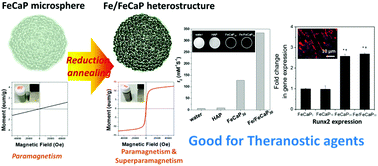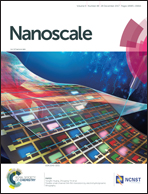Osteoinductive superparamagnetic Fe nanocrystal/calcium phosphate heterostructured microspheres†
Abstract
Functional magnetic and biocompatible particles are of great interest because of their potential use in various bioapplications such as hyperthermia for cancer treatment, magnetic resonance imaging (MRI) contrast agents and drug delivery. Herein, we introduce a facile method for synthesizing magnetic Fe nanocrystal/Fe-substituted calcium phosphate (Fe/FeCaP) heterostructured microspheres using a two-step procedure: (1) one-pot hydrothermal synthesis to prepare uniform-sized FeCaP microspheres and (2) post-reduction annealing at 600 °C for Fe extraction from FeCaP. This approach results in the fabrication of Fe/FeCaP heterostructured microspheres that exhibit superparamagnetism with a saturation magnetization of 10.77 emu g−1. The Fe/FeCaP particles annealed at 600 °C show a much higher magnetic moment compared with the non-annealed FeCaP particles. Moreover, T2-weighted MRI phantom images reveal that the Fe/FeCaP heterostructured microspheres possess higher relaxivity than paramagnetic FeCaP, demonstrating their potential as superior and biocompatible MRI contrast agents. Moreover, the enhancement in osteoconductivity for Fe/FeCaP microspheres without any evidence of cytotoxicity was verified. Our results demonstrate the great potential of multi-functional Fe/FeCaP microspheres for use as biocompatible bone regeneration agents as well as MRI contrast agents.



 Please wait while we load your content...
Please wait while we load your content...